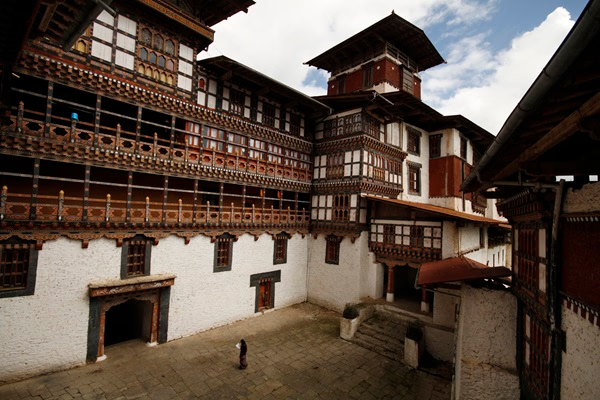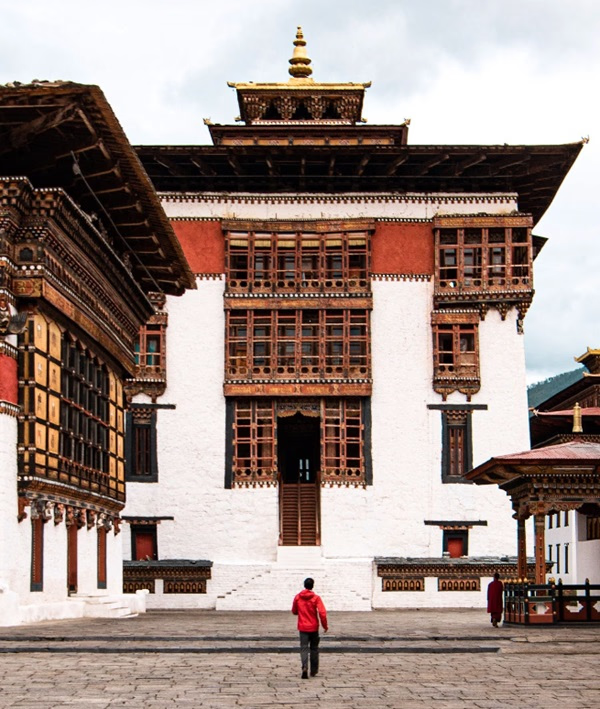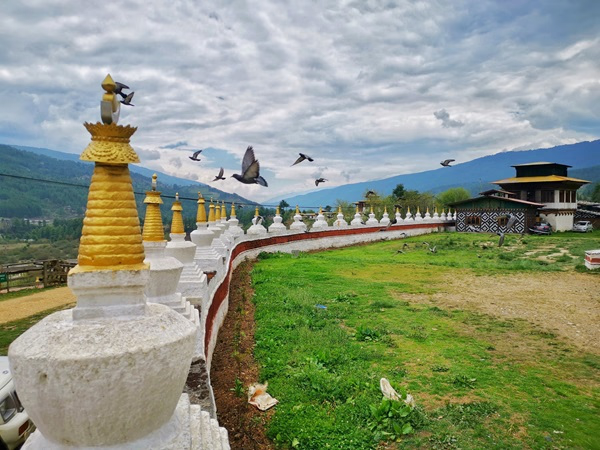
Bhutanese architecture shines with its unique blend of tradition and spirituality, making it a captivating aspect of Bhutan's cultural heritage. From the majestic dzongs to the serene temples, Bhutanese architecture tells a story of a land deeply connected to its history and beliefs.
This guide will explore the must-see architectural wonders that define Bhutan, whether you're an avid traveler or a curious explorer ready to explore Bhutanese architecture's rich heritage and beauty.
Read on to learn the secrets and marvels that await you in this enchanting Himalayan kingdom.
The Majestic Dzongs: Guardians Of Bhutanese Heritage
Dzongs are massive fortress-monasteries that serve both religious and administrative functions in Bhutan. These impressive structures are a cornerstone of Bhutanese architecture and embody the country's unique spiritual and secular life blend.
Historical Background Of Dzongs
Dzongs were first constructed in the 17th century by Zhabdrung Ngawang Namgyal, a unifying figure in Bhutanese history.
They were strategically built to serve as fortresses, protecting against invasions and housing monks and administrative offices. The dual-purpose design reflects the integration of governance and religion in Bhutanese culture.
Key Architectural Features Of Dzongs

Massive stone walls, wide courtyards, and intricate woodwork characterize dzongs. The buildings typically feature a central tower, or utse, which rises above the surrounding structures.
The walls are often bright white with red and gold accents, and the roofs are adorned with elaborate carvings and religious symbols. These features enhance the dzongs' aesthetic appeal and defensive capabilities.
Famous Dzongs To Visit
Visiting dzongs is a must for anyone interested in Bhutanese architecture. Here are a few you shouldn't miss:
Paro Dzong: This fortress, also known as Rinpung Dzong, monastery overlooks the Paro Valley and is one of Bhutan's most iconic landmarks. Its unique architecture with panoramic views make it a favorite among travelers.
Punakha Dzong: Punakha Dzong, situated between Pho Chhu and Mo Chhu rivers, is renowned for its amazing beauty and historical significance. It served as the seat of government until the mid-20th century and remained an important religious center.
Trongsa Dzong: Trongsa Dzong is perched on a ridge overlooking the Mangde Chhu River and is the largest fortress in Bhutan. Its strategic location offers commanding views of the surrounding landscape, and its complex architecture showcases the grandeur of Bhutanese design.
Serene Sanctuaries: Exploring Bhutan's Temples And Lhakhangs
Temples and Lhakhangs are the heart of spiritual life in Bhutan, each offering a unique glimpse into the country's rich religious heritage. These serene sanctuaries testify to Bhutanese architecture's intricate beauty and deep-rooted spiritual significance.
Architectural Styles And Religious Significance
Bhutanese temples, known as Lhakhangs, are often modest single-story structures surrounding a courtyard. Their simple exteriors belie the richness inside, where walls are adorned with colorful frescoes and intricate wood carvings depicting religious themes.
Lhakhangs usually feature high thresholds, red stripes along the upper walls, and gilded copper roofs, symbolizing the sacred nature of the space.
Notable Temples To Explore
Exploring these temples profoundly connects to Bhutan's spiritual traditions and architectural artistry. Here are a few notable Lhakhangs you should visit:
Kyichu Lhakhang: Located in the Paro Valley, this is one of Bhutan's oldest and most revered temples. Legend has it that it was built to subdue a demoness, preventing the spread of Buddhism.
The temple's peaceful ambiance and beautiful gardens make it a must-visit for travelers.
Jambay Lhakhang: This ancient temple, situated in Bumthang, is believed to have been built in the 7th century by the Tibetan King Songtsen Gampo.
It is one of the 108 temples he constructed to subdue evil spirits across the region. Jambay Lhakhang is renowned for its annual festival, which features traditional masked dances and rituals.
Chimi Lhakhang: Known as the "Fertility Temple," Chimi Lhakhang is located in the Punakha District and is dedicated to Drukpa Kunley, a revered saint popular for his unconventional methods of teaching Buddhism.
The temple is famous for its fertility blessings, and many couples visit seeking to conceive a child.
The Spiritual Experience
Visiting these temples is more than just an architectural tour; it's a spiritual journey that offers insight into the deep faith and traditions of the Bhutanese people. The serene environments, coupled with the beautiful artistry, make these temples sanctuaries of peace and contemplation.
Sacred Monuments: The Enigmatic Chortens Of Bhutan
Chortens, or stupas, are sacred monuments scattered across Bhutan, each carrying profound spiritual significance and architectural charm. These enigmatic structures serve as places of worship and reflection, embodying the essence of Bhutanese faith and artistry.

The Purpose And Symbolism Of Chortens
Chortens are built as receptacles of worship, commemorating significant events or honoring revered figures. They are designed to symbolize the Buddha's mind, body, and speech and often contain sacred relics.
Each element of a chorten represents a different aspect of Buddhist cosmology:
The base symbolizes the earth.
The dome represents water.
The spire denotes fire.
The umbrella signifies air.
The pinnacle embodies space.
Different Styles Of Chortens
Bhutan boasts a variety of chorten styles, each with unique architectural features and symbolic meanings:
Nepalese-Style Chortens: These large, domed structures are often found in the western regions of Bhutan. They are hewn from stone and whitewashed, with intricate carvings and detailed ornamentation.
Tibetan-Style Chortens: Found primarily in eastern and central Bhutan, these Chortens feature flared bases and are sometimes accompanied by wooden superstructures. They reflect the strong cultural and religious ties between Bhutan and Tibet.
Indigenous Bhutanese Chortens: Unique to Bhutan, these Chortens typically consist of a square stone pillar with a khemar near the top. They may be adorned with a ball and crescent to depict the sun and moon, symbolizing the harmony of the universe.
Important Chortens To Visit
Exploring Bhutan's Chortens offers a glimpse into the country's spiritual landscape and architectural ingenuity. Here are some noteworthy Chortens to include in your journey:
National Memorial Chorten: Located in the capital city of Thimphu, this chorten was built in memory of Bhutan's third king, Jigme Dorji Wangchuck. It is one of Bhutan's most prominent religious sites, with locals and visitors alike circumambulating it to gain merit and blessings.
Dochula Chortens: These 108 Chortens are situated at the Dochula Pass, offering breathtaking views of the Himalayas. Built by the Queen Mother in honor of Bhutanese soldiers who died in a military conflict, they stand as a testament to peace and remembrance.
Kurjey Lhakhang Chortens: Kurjey Lhakhang is a complex of three temples, with the third temple constructed in 1984 by Ashi Kesang Wangchuck, the Queen of the Third King, under the guidance of Dilgo Khyentse Rinpoche. She also built a wall of 108 Chortens, known as Jangchub Chortens, around the entire complex and had the courtyard paved with stone slabs. These Chortens symbolize Buddha's victory over evil forces and the purity of his enlightenment.

A Spiritual And Visual Feast
Visiting Chortens is a deeply spiritual experience, offering moments of reflection and connection to Bhutan's rich religious heritage. The beauty and symbolism of these sacred monuments provide travelers with a profound sense of peace and a deeper appreciation for Bhutanese culture.
Traditional Bhutanese Houses: Timeless Craftsmanship
Traditional Bhutanese houses testify to the country's dedication to preserving its cultural heritage. These homes are not just dwellings but symbols of Bhutanese craftsmanship, built to withstand the test of time and the challenges of the natural environment.
Construction Materials And Techniques
Bhutanese houses are constructed using local materials like timber, stone, and rammed earth. The walls are often made from mud and rammed earth, providing excellent insulation against the cold.
Stone is more commonly used in eastern Bhutan due to its abundance in the region. The roofs are typically wooden shingles, and the interiors are decorated with intricate wood carvings and colorful paintings.
Regional Variations
The architecture of Bhutanese houses varies across regions, adapting to local climates and available materials:
Lowland Houses: In lower altitudes, homes are often built with bamboo and wood. These materials are readily available and well-suited to the milder climate.
Highland Houses: In higher altitudes, stone becomes the primary building material due to its durability and ability to retain heat. These houses are made to withstand harsh weather conditions.
Examples Of Traditional Houses
Visiting traditional Bhutanese houses offers a glimpse into the country's architectural heritage and way of life. Some notable examples include:
Gangtey Village Houses: Located in the Phobjikha Valley, Gangtey Village houses are renowned for their beautiful woodwork and picturesque setting.
Bumthang Valley Houses: The houses in Bumthang Valley are known for using stone and intricate interior decorations, reflecting the region's rich cultural heritage.
Exploring these traditional homes gives travelers a deeper understanding of Bhutanese craftsmanship and the country's commitment to preserving its architectural traditions.
Modern Influences Of Bhutanese Architecture
While Bhutan takes great pride in its traditional architecture, the country is not immune to modern influences. In recent years, Bhutanese architecture has begun applying contemporary elements, creating a harmonious blend of old and new architecture.
Integration Of Modern Elements
Modern Bhutanese buildings often combine traditional design principles with contemporary materials and technologies. This integration ensures that new constructions remain true to Bhutanese aesthetics while meeting the needs of modern society.
For example, new structures may use reinforced concrete for added durability but still feature traditional woodwork and carvings.
Examples Of Contemporary Bhutanese Architecture
Several modern buildings in Bhutan showcase this blend of tradition and innovation:
Bhutan Broadcasting Service (BBS) Tower: This building in Thimphu combines traditional Bhutanese architectural elements with modern broadcasting technology. Its design reflects Bhutan's commitment to preserving its cultural identity while embracing technological advancements.
Le Meridien Thimphu: This luxury hotel seamlessly blends traditional Bhutanese aesthetics with contemporary amenities, offering guests a unique experience that honors Bhutan's heritage.
Preservation And Sustainability Efforts
Bhutan is dedicated to preserving its architectural heritage while promoting sustainable development. Efforts are underway to ensure that new buildings adhere to traditional design principles and use eco-friendly materials and practices. These initiatives aim to protect Bhutan's cultural identity and natural environment for future generations.
Conclusion About Bhutanese Architecture
Bhutanese architecture is a captivating blend of spirituality, tradition, and artistry. From majestic dzongs to serene temples, each structure tells a story of Bhutan's rich cultural heritage.
For a seamless travel experience, DrukAsia is your go-to Bhutan tour agency. We offer expertly curated tours guided by knowledgeable experts that highlight the best of Bhutanese architecture.
Embark on your Bhutan adventure with DrukAsia. Book now and explore the timeless beauty of Bhutanese architecture!
Frequently Asked Questions About Bhutanese Architecture
What Are The Key Features Of Bhutanese Religious Structures?
Bhutanese religious structures, such as temples and monasteries, are known for their high thresholds, gilded copper roofs, and intricate wall paintings. They serve as places of worship and homes for spiritual or religious figures.
How Do Traditional Buildings Reflect Bhutanese Culture?
Traditional buildings in Bhutan reflect the country's cultural heritage through their use of local materials like timber and rammed earth, as well as decorative elements such as wood carvings and murals.
What Is The Significance Of The Central Tower Temple In Dzong Architecture?
The central tower temple, or utse, in dzong architecture, is a prominent feature that rises above the fortress monastery. It often houses important religious artifacts and serves as a symbol of spiritual authority.
Why Should One Embark On An Architectural And Spiritual Journey In Bhutan?
An architectural and spiritual journey in Bhutan offers a one-of-a-kind way to explore the country's rich heritage through its traditional structures and religious centers, providing deep insights into Bhutanese culture and beliefs.
Check out building design and architecture around the world that are inspired by the unique Bhutanese architecture.
How Are Traditional Styles Preserved In Modern Bhutanese Architecture?
Modern Bhutanese architecture often blends traditional styles with contemporary elements, ensuring that new buildings respect historical design principles while applying modern materials and technology. The government of Bhutan has taken careful measures to preserve the traditional Bhutanese architecture. The specifications and rules for building dzongs are codified in Driglam Namzha - Bhutan's Code of Etiquette.
